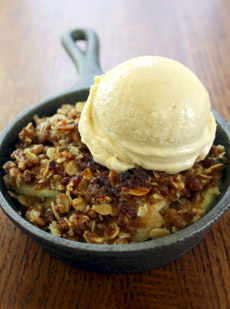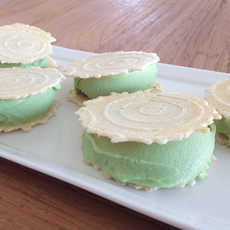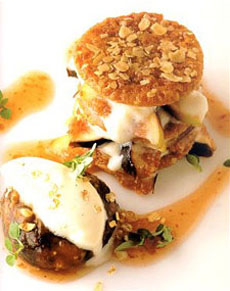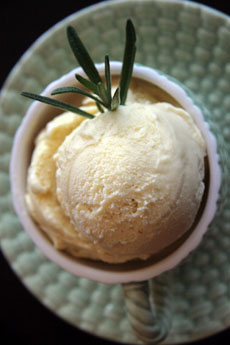Savory Ice Cream, How To Serve It & The History Of Ice Cream
|
We thought about labeling this article Food Fun instead of a Tip Of The Day. After all, savory ice cream isn’t everyday fare.
Then, we remembered that our purpose is to expand your food horizons (and impress your guests), so here goes. > The year’s 50+ ice cream holidays. > The history of ice cream. Savory ice cream flavored with cheese and/or herbs—no sugar or just a small amount—is not a new concept. We published a large collection of cheese ice cream recipes 11 years ago, but the savory recipes date to way before that. You can find recipes for formaggio gelato (cheese ice cream) and formaggio di parmigiano gelato (Parmesan ice cream) in older Italian cookbooks. It replaced the cheese course at the end of summer lunches, or was cut into slices and served as a first course with ham and hard-boiled eggs. We have several recipes, below; but the basic Italian recipe is simple: 1. GRATE one pound of Grana Padano or Parmigiano Reggiano (or crumble Gorgonzola; combine with one quart of heavy cream and a pinch of salt and pepper. 2. STIR over a moderate flame until the mixture becomes creamy. This infuses the cream with Parmesan flavor. 3. REMOVE from the heat, cool, strain and process in an ice cream maker according to manufacturer’s directions. If you don’t have an ice cream maker, you can freeze the mixture in a container and stir at regular intervals (for a less creamy texture). Use your imagination! For starters: This recipe is much simpler to make. Use it with cold vegetable soups and the other serving suggestions above. |
 [1] Rosemary ice cream on an herb salad (photo © Rosetta Restaurant | Mexico City).
|
|
|
We make a similarly simple recipe of blender gazpacho: tomatoes, basil and olive oil with optional chopped bell peppers, cucumbers and onions (it depends on how much time or desire we have for chopping). Serve it in a Martini glass or large wine goblet, topped with a small scoop of ice cream. Ingredients 1. HEAT the cream in a saucepan over medium heat; bring to a simmer. 2. STIR in the Parmesan cheese and continue stir until the cheese is melted. Stir in a dash of fresh ground pepper and remove to a small bowl to cool. When cool… 3. PLACE the mixture in a small freezer-proof bowl or plastic container. Cover the container and place it in the freezer for 1-2 hours. 4. SCOOP little balls of the frozen Parmesan ice cream, using a melon baller or a teaspoon. Place a ball of into each bowl of soup just before serving. Garnish with a sprig of fresh herb. |
||
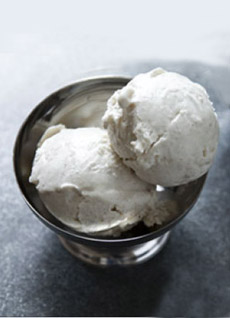 [5] Blue cheese ice cream. Here’s a recipe (photo © Yummly [now closed]).
|
MORE CHEESE ICE CREAM RECIPES
This recipe is sweetened, but you can reduce the honey to 1/8 or 1/4 of a cup for a more savory ice cream, or add just a tablespoon. You can also substitute basil. If you’d like the herb flavor to be stronger, use more next time. You can make this recipe up to four days in advance. 1. COMBINE the cream, milk, honey and rosemary in large saucepan. Stir over medium heat until small bubbles form around edges of pan. Remove from the heat; cover and let steep 30 minutes. 2. DISCARD the rosemary and put the pan back on the stove. Bring the contents to a simmer, then remove from the heat. 3. WHISK the egg yolks and salt in a medium bowl. Gradually add the hot cream mixture, whisking until thoroughly combined. (The eggs and cream make this a custard, the style known as French ice cream. See the different types of ice cream.) 4. RETURN the custard to the saucepan. Stir over medium-low heat until the custard thickens slightly and coats back of spoon. This should take 4 to 5 minutes and the mixture should register 165°F to 170°F on a thermometer. Do not boil! 5. STRAIN the mixture into a medium bowl. Set the bowl into a larger bowl containing a slurry of ice and water. Allow to cool, about 10 minutes, stirring occasionally. 6. REMOVE the custard bowl from the slurry. Cover it with plastic wrap and chill for at least 4 hours. 7. TRANSFER the custard to an ice cream maker and follow the manufacturer’s instructions. Transfer the churned ice cream to a container. Cover and freeze until firm, at least 4 hours. |
|
|
THE HISTORY OF ICE CREAM Fruit ices are thousands of years old, dating back to ancient China. But gelato, the first type of ice cream, is comparatively recent. The original concept, a sherbet-like concoction, came from Northern China in the more than 4,000 years ago, before the 2nd century B.C.E. Snow and saltpeter in a container served as an ancient ice cream maker to freeze ingredients, the snow mixed with fruit juices, honey and aromatic spices. A modern form of it still exists, called snow cream. You can make it with a fresh batch of snow: Here’s the recipe. Through trade routes, the frozen dessert recipe was introduced to Persia—about 2,500 years ago. The Persians called the frozen concoction sharbat, “fruit ice” in Arabic. We know it as sherbet, sorbet or sorbetto. Alexander the Great, who battled the Persians for 10 years before finally toppling the Persian Empire in 330 B.C.E., “discovered” the fruit ices and returned to Greece with the knowledge. Within three centuries, Emperor Nero was serving fruit juices mixed with honey and snow at his banquets, dispatching the fastest runners to the mountaintops to bring back the snow. Fruit ice arrived in Europe with the Arab invasions of Sicily in the fifth century. Italian granita was born, flavored with a wide range of fruits including citrus. Coffee ice was also made. It took until the late 1500’s in Florence, for fruit ice to be adapted to gelato. The original ice cream, gelato was (and is) made with cream and eggs. This combination enables a more intense showcasing of the fruits, nuts and other flavors. (The key differences between gelato and ice cream are less cream/more milk and less air [overrun].) The invention is credited to Bernardo Buontalenti, a multi-talented genius born Bernardo Delle Girandole (c. 1531 to 1608). Buontalenti, his professional name, means great talent. He was an architect, theatrical designer, military engineer and artist. It is believed that he created gelato for a Medici banquet. Buontalenti, who spent his life in the employ of the Medici family, was, among other things, the impresario of the fabulous Medici banquets. While no historical record exists that names Buontalenti as the creator, he is a likely candidate. Gelato spread from Italy to the rest of Europe. This is attributed to another Italian, Catarina de’ Medici, who married the future King Henri II of France. (She was only 14 when she married; no wonder she liked ice cream). Here’s the full history of ice cream, to modern times. CHECK OUT WHAT’S HAPPENING ON OUR HOME PAGE, THENIBBLE.COM. |
||
